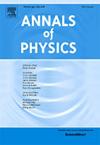A preference for dynamical phantom dark energy using one-parameter model with Planck, DESI DR1 BAO and SN data
IF 3
3区 物理与天体物理
Q2 PHYSICS, MULTIDISCIPLINARY
引用次数: 0
Abstract
Baryon Acoustic Oscillation (BAO) provides a powerful tool to measure cosmic expansion and consequently the nature of the Dark Energy (DE). Recent precise BAO measurements by Dark Energy Spectroscopic Instrument data release 1 (DESI DR1), when combined with Cosmic Microwave Background (CMB) data from Planck and Supernovae of Type Ia (SN Ia), favor evolving dark energy over cosmological constant. This result is strongly related to the assumed priors on the Chevallier–Polarski–Linder (CPL) parametrization of DE. We test another parametrization which introduces two free parameters and , only is independent. Thus, it reduces the parameter space compared to the CPL model, which derives a more robust preference for evolving DE, if any. The model potentially produces three cosmological scenarios according to the values of its parameters. For , the CDM model is recovered, quintessence for , and phantom for . In the present study, we test the model on the background level, and, to our knowledge for the first time, on the linear perturbation level. Bayesian evidence analysis shows a weak preference () for dynamical DE in the phantom regime over the cosmological constant DE using Planck, DESI, and PantheonPlus & SH0ES data, similarly the AIC analysis supports dynamical DE scenario for the same data. The model predicts current phantom DE and km/s/Mpc when Planck+DESI data is used, which decreases the tension with local measurements to level.
基于Planck、DESI DR1 BAO和SN数据的单参数模型对动态幻影暗能量的偏好
重子声学振荡(BAO)为测量宇宙膨胀和暗能量(DE)的本质提供了一个强大的工具。最近由暗能量光谱仪器数据发布1 (DESI DR1)进行的精确BAO测量,结合来自普朗克和Ia型超新星(SN Ia)的宇宙微波背景(CMB)数据,更倾向于演化中的暗能量而不是宇宙常数。该结果与DE的Chevallier-Polarski-Linder (CPL)参数化的假设先验密切相关。我们测试了另一个参数化,该参数化引入了两个自由参数n和α,只有n是独立的。因此,与CPL模型相比,它减少了参数空间,CPL模型对演化DE(如果有的话)有更强的偏好。该模型根据其参数值可能产生三种宇宙学情景。当n=3时,恢复ΛCDM模型,n<;3为精粹模型,n>;3为幻像模型。在本研究中,我们在背景水平上测试了模型,并且,据我们所知,这是第一次在线性扰动水平上测试模型。贝叶斯证据分析显示,使用普朗克、DESI和PantheonPlus & SH0ES数据,在幻影状态下的动态DE比宇宙学常数DE有弱偏好(lnB≤1.8),同样,AIC分析支持相同数据的动态DE场景。当使用Planck+DESI数据时,该模型预测当前的幻影DE wde为0=−1.073±0.032,H0=70.9±1.4 km/s/Mpc,将H0局部测量的张力降低到1.2σ水平。
本文章由计算机程序翻译,如有差异,请以英文原文为准。
求助全文
约1分钟内获得全文
求助全文
来源期刊

Annals of Physics
物理-物理:综合
CiteScore
5.30
自引率
3.30%
发文量
211
审稿时长
47 days
期刊介绍:
Annals of Physics presents original work in all areas of basic theoretic physics research. Ideas are developed and fully explored, and thorough treatment is given to first principles and ultimate applications. Annals of Physics emphasizes clarity and intelligibility in the articles it publishes, thus making them as accessible as possible. Readers familiar with recent developments in the field are provided with sufficient detail and background to follow the arguments and understand their significance.
The Editors of the journal cover all fields of theoretical physics. Articles published in the journal are typically longer than 20 pages.
 求助内容:
求助内容: 应助结果提醒方式:
应助结果提醒方式:


